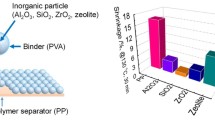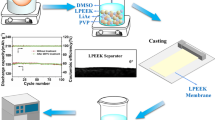Abstract
A series of pore-controllable polyamine (PAI) layer-coated polyolefin (PE) separators (PAI-PE-1, PAI-PE-2, and PAI-PE-3) are prepared by using a phase-transfer and gravure-printing method and used to improve the safety of pouch lithium-ion batteries (LIBs) based on a PAI “guest-host transition” and PE “pore on-off” cooperative strategy. And the safety mechanism for the LIBs using PAI-PE-1, PAI-PE-2, and PAI-PE-3 separators with pore sizes of approximately 0.02, 0.17, and 0.85 μm is discussed. In the overcharge, nail, and hot box tests, the LIBs with PAI-PE separators all meet safety requirements, while the LIBs with PE separators exhibit either fire or smoke issues. The LIBs with PAI-PE-1 separators have the lowest temperature of 102 °C and the highest residual voltage of 3.97 V in the nail and hot box tests, respectively, and the LIBs with PAI-PE-3 separators have the lowest temperature of 129 °C in the overcharge test. The mechanism for the enhanced safety of LIBs with PAI-PE separators is ascribed to a PAI “guest-host transition” and PE “pore on-off” cooperative process. These results indicate that this pore-controllable PAI-PE separator has promising prospects in the application of LIBs with enhanced safety requirements.

Graphical abstract








Similar content being viewed by others
References
Zhu J, Wierzbicki T, Li W (2018) A review of safety-focused mechanical modeling of commercial lithium-ion batteries. J Power Sources 378:153–168
Deng YM, Kang TX, Ma Z, Tan XX, Song XN, Wang Z, Pang PP, Shu D, Zuo XX, Nan JM (2019) Safety influences of the Al and Ti elements modified LiCoO2 materials on LiCoO2/graphite batteries under the abusive conditions. Electrochim Acta 295:709–709
Deng YM, Wang Z, Ma Z, Nan JM (2019) Positive-temperature-coefficient graphite anode as a thermal runaway firewall to improve the safety of LiCoO2/graphite batteries under abusive conditions. Energy Technol. https://doi.org/10.1002/ente.201901037
Wang QS, Ping P, Zhao XJ, Chu GQ, Sun JH, Chen CH (2012) Thermal runaway caused fire and explosion of lithium ion battery. J Power Sources 208:210–224
Feng XN, Ouyang MG, Liu X, Lu LG, Xia Y, He XM (2018) Thermal runaway mechanism of lithium ion battery for electric vehicles: a review. Energ Stor Mater 10:246–267
Liu JC, Yang K, Mo YD, Wang SJ, Han DM, Xiao M, Meng YZ (2018) Highly safe lithium-ion batteries: high strength separator from polyformaldehyde/cellulose nanofibers blend. J Power Sources 400:502–510
Nunes-Pereira J, Costa CM, Lanceros-Méndez S (2015) Polymer composites and blends for battery separators: state of the art, challenges and future trends. J Power Sources 281:378–398
Fu D, Luan B, Argue S, Bureau MN, Davidson IJ (2012) Nano SiO2 particle formation and deposition on polypropylene separators for lithium-ion batteries. J Power Sources 206:325–333
Shi C, Zhang P, Chen LX, Yang PT, Zhao JB (2014) Effect of a thin ceramic-coating layer on thermal and electrochemical properties of polyethylene separator for lithium-ion batteries. J Power Sources 270:547–553
Choi JA, Kim SH, Kim DW (2009) Enhancement of thermal stability and cycling performance in lithium-ion cells through the use of ceramic-coated separators. J Power Sources 195:6192–6196
Zhang ZX, Yuan WH, Li L (2018) Enhanced wettability and thermal stability of nano-SiO2/poly(vinyl alcohol)-coated polypropylene composite separators for lithium-ion batteries. Particuology 37:91–98
Li XF, Zhang MZ, He JL, Wu DZ, Meng JW, Ni PH (2014) Effects of fluorinated SiO2 nanoparticles on the thermal and electrochemical properties of PP nonwoven/PVdF-HFP composite separator for Li-ion batteries. J Membr Sci 455:368–374
Kim KJ, Kwon HK, Park MS, Yim T, Yu JS, Kim YJ (2014) Ceramic composite separators coated with moisturized ZrO2 nanoparticles for improving the electrochemical performance and thermal stability of lithium ion batteries. Phys Chem Chem Phys 16(20):9337–9343
Chung YS, Yoo SH, Kim CK (2009) Enhancement of meltdown temperature of the polyethylene lithium-ion battery separator via surface coating with polymers having high thermal resistance. Ind Eng Chem Res 48:4346–4351
Rajesh S, Maheswari P, Senthilkumar S, Jayalakshmi A, Mohan D (2011) Preparation and characterisation of poly (amide-imide) incorporated cellulose acetate membranes for polymer enhanced ultrafiltration of metal ions. Chem Eng J 171:33–44
Shi JL, Fang LF, Li H, Zhang H, Zhu BK, Zhu LP (2013) Improved thermal and electrochemical performances of PMMA modified PE separator skeleton prepared via dopamine-initiated ATRP for lithium ion batteries. J Membr Sci 437:160–168
Song YZ, Yuan JJ, Yin X, Zhang Y, Lin CE, Sun CC, Fang LF, Zhu BK, Zhu LP (2018) Effect of polyphenol-polyamine treated polyethylene separator on the ionic conduction and interface properties for lithium-metal anode batteries. J Electroanal Chem 816:68–74
Man CZ, Jiang P, Wong KW, Zhao Y, Tang CY, Fan MK, Lau WM, Mei J, Li SM, Liu H, Hui D (2014) Enhanced wetting properties of a polypropylene separator for a lithium-ion battery by hyperthermal hydrogen induced cross-linking of polyethylene oxide. J Mater Chem A 2:11980–11986
Wang H, Wu JJ, Cai C, Guo J, Fan HS, Zhu CZ, Dong HX, Zhao N, Xu J (2014) Mussel inspired modification of polypropylene separators by catechol/polyamine for Li-ion batteries. ACS Appl Mater Interfaces 6:5602–5608
Deng YM, Song XN, Ma Z, Zhang XH, Shu D, Nan JM (2016) Al2O3/PVdF-HFP-CMC/PE separator prepared using aqueous slurry and post-hot-pressing method for polymer lithium-ion batteries with enhanced safety. Electrochim Acta 212:416–425
Song KW, Kim CK (2010) Coating with macroporous polyarylate via a nonsolvent induced phase separation process for enhancement of polyethylene separator thermal stability. J Membr Sci 352:239–246
Li Z, Xiong Y, Sun SP, Zhang L, Li SS, Liu XG, Xu ZH, Xu SM (2018) Tri-layer nonwoven membrane with shutdown property and high robustness as a high-safety lithium ion battery separator. J Membr Sci 565:50–60
Xiong BJ, Chen R, Zeng FXY, Kang J, Men YF (2018) Thermal shrinkage and microscopic shutdown mechanism of polypropylene separator for lithium-ion battery: in-situ ultra-small angle X-ray scattering study. J Membr Sci 545:213–220
Kim YK, Lee WY, Kim KJ, Yu JS, Kim YJ (2016) Shutdown-functionalized nonwoven separator with improved thermal and electrochemical properties for lithium-ion batteries. J Power Sources 305:225–232
Deng YM, Ma Z, Song XN, Cai ZD, Pang PP, Wang Z, Zeng RH, Shu D, Nan JM (2018) From the charge conditions and internal short-circuit strategy to analyze and improve the overcharge safety of LiCoO2/graphite batteries. Electrochim Acta 282:295–303
Deng YM, Kang TX, Song XN, Ma Z, Zuo XX, Shu D, Nan JM (2019) Analysis on the constant-current overcharge electrode process and self-protection mechanism of LiCoO2/graphite batteries. J Solid State Electrochem 23:407–417
Funding
This work was financially supported by the Scientific and Technological Plan Projects of Guangzhou City (No. 201902010068) and Zhuhai City (No. ZH01084702180037HJL), Peoples Republic of China.
Author information
Authors and Affiliations
Corresponding authors
Additional information
Publisher’s note
Springer Nature remains neutral with regard to jurisdictional claims in published maps and institutional affiliations.
Electronic supplementary material
ESM 1
(DOC 541 kb)
Rights and permissions
About this article
Cite this article
Wang, Z., Chen, J., Ye, B. et al. A pore-controllable polyamine (PAI) layer-coated polyolefin (PE) separator for pouch lithium-ion batteries with enhanced safety. J Solid State Electrochem 24, 843–853 (2020). https://doi.org/10.1007/s10008-019-04488-y
Received:
Revised:
Accepted:
Published:
Issue Date:
DOI: https://doi.org/10.1007/s10008-019-04488-y




